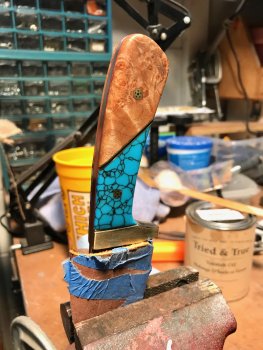Are you making two-piece scales, or a hidden tang handle with a ferrule?
For scales, I use a liner as a backer and I leave the wood/material in rectangular form rather than trying to glue up a profiled handle shape. The liner provides a continuous substrate to act as reinforcement. You can also put a strip of liner material in the joint between the two pieces. Epoxy every side that touches something else. Then I use clamps on the edge of a workbench such that there is a clamp on each piece of the handle, clamping it down to the workbench. (wax paper or something under the liner material will catch epoxy squeeze out and prevent you from gluing it all to the benchtop.) Once everything is clamped, recheck it after a minute to make sure nothing has moved out of place. (uneven clamp pressure will cause the pieces to drift, so you might have to readjust your clamps to make sure they aren't pushing your pieces around.) Once everything is clamped up and not moving, let it sit until the next day.
For a hidden tang, I assemble the handle / spacers / ferrule on the tang the way it's going to go- just to make sure I have everything in place. Then I chuck the handle in vise and remove the blade and fill the cavity with epoxy. Then set the blade back down into the handle. I let gravity do the work. If everything is square and has been pre-fit correctly then the blade will sit vertically and there will be no gaps. What epoxy needs to squeeze out will squeeze out. Check it in about ten minutes, if all is well come back tomorrow.

